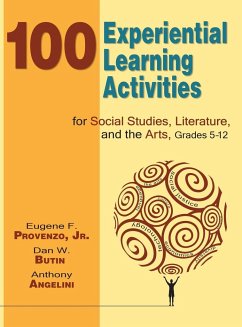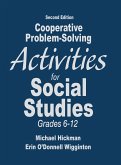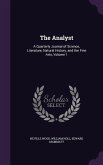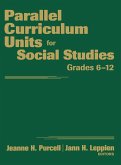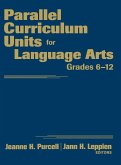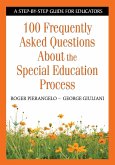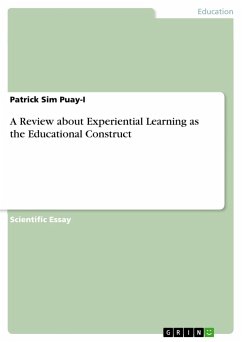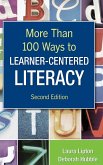Jr. Eugene F. Provenzo, Dan W. Butin, Anthony Angelini
100 Experiential Learning Activities for Social Studies, Literature, and the Arts, Grades 5-12
Jr. Eugene F. Provenzo, Dan W. Butin, Anthony Angelini
100 Experiential Learning Activities for Social Studies, Literature, and the Arts, Grades 5-12
- Gebundenes Buch
- Merkliste
- Auf die Merkliste
- Bewerten Bewerten
- Teilen
- Produkt teilen
- Produkterinnerung
- Produkterinnerung
Facilitates student engagement through active learning and provides easy-to-use matrices linking McREL, NCTE, and NCSS standards to activities in history, economics, literature, and the arts.
Andere Kunden interessierten sich auch für
![Cooperative Problem-Solving Activities for Social Studies, Grades 6-12 Cooperative Problem-Solving Activities for Social Studies, Grades 6-12]() Michael HickmanCooperative Problem-Solving Activities for Social Studies, Grades 6-1289,99 €
Michael HickmanCooperative Problem-Solving Activities for Social Studies, Grades 6-1289,99 €![The Analyst: A Quarterly Journal of Science, Literature, Natural History, and the Fine Arts, Volume 1 The Analyst: A Quarterly Journal of Science, Literature, Natural History, and the Fine Arts, Volume 1]() Neville WoodThe Analyst: A Quarterly Journal of Science, Literature, Natural History, and the Fine Arts, Volume 144,99 €
Neville WoodThe Analyst: A Quarterly Journal of Science, Literature, Natural History, and the Fine Arts, Volume 144,99 €![Parallel Curriculum Units for Social Studies, Grades 6-12 Parallel Curriculum Units for Social Studies, Grades 6-12]() Jeanne H. PurcellParallel Curriculum Units for Social Studies, Grades 6-1296,99 €
Jeanne H. PurcellParallel Curriculum Units for Social Studies, Grades 6-1296,99 €![Parallel Curriculum Units for Language Arts, Grades 6-12 Parallel Curriculum Units for Language Arts, Grades 6-12]() Jeanne H. PurcellParallel Curriculum Units for Language Arts, Grades 6-1297,99 €
Jeanne H. PurcellParallel Curriculum Units for Language Arts, Grades 6-1297,99 €![100 Frequently Asked Questions about the Special Education Process 100 Frequently Asked Questions about the Special Education Process]() Roger Pierangelo100 Frequently Asked Questions about the Special Education Process33,99 €
Roger Pierangelo100 Frequently Asked Questions about the Special Education Process33,99 €![A Review about Experiential Learning as the Educational Construct A Review about Experiential Learning as the Educational Construct]() Patrick Sim Puay-IA Review about Experiential Learning as the Educational Construct15,95 €
Patrick Sim Puay-IA Review about Experiential Learning as the Educational Construct15,95 €![More Than 100 Ways to Learner-Centered Literacy More Than 100 Ways to Learner-Centered Literacy]() Laura LiptonMore Than 100 Ways to Learner-Centered Literacy80,99 €
Laura LiptonMore Than 100 Ways to Learner-Centered Literacy80,99 €-
-
-
Facilitates student engagement through active learning and provides easy-to-use matrices linking McREL, NCTE, and NCSS standards to activities in history, economics, literature, and the arts.
Hinweis: Dieser Artikel kann nur an eine deutsche Lieferadresse ausgeliefert werden.
Hinweis: Dieser Artikel kann nur an eine deutsche Lieferadresse ausgeliefert werden.
Produktdetails
- Produktdetails
- Verlag: Corwin
- Seitenzahl: 176
- Erscheinungstermin: 21. Februar 2008
- Englisch
- Abmessung: 286mm x 221mm x 14mm
- Gewicht: 719g
- ISBN-13: 9781412939997
- ISBN-10: 1412939992
- Artikelnr.: 23067879
- Herstellerkennzeichnung
- Libri GmbH
- Europaallee 1
- 36244 Bad Hersfeld
- gpsr@libri.de
- Verlag: Corwin
- Seitenzahl: 176
- Erscheinungstermin: 21. Februar 2008
- Englisch
- Abmessung: 286mm x 221mm x 14mm
- Gewicht: 719g
- ISBN-13: 9781412939997
- ISBN-10: 1412939992
- Artikelnr.: 23067879
- Herstellerkennzeichnung
- Libri GmbH
- Europaallee 1
- 36244 Bad Hersfeld
- gpsr@libri.de
Gene Provenzo is one of the nation's leading scholars in the foundations of education. He holds the rank of full professor at the University of Miami. He has won numerous awards throughout his career in both teaching and research and sits on many editorial boards. He has authored over ten books and has contributed chapters to many more. He has authored scores of articles in a wide range of areas in education. His recent projects include Teaching, Learning, and Schooling (Allyn & Bacon, 2002), a critically-oriented introduction to the foundations of education textbook, and the forthcoming Readings in Educational Thought (SAGE, 2005).
Preface Acknowledgments About the Authors Introduction Matrices NCSS McRel 1. Creating a Language 2. Point-of-View Pictures 3. Rosie the Riveter 4. Columbus and the Discovery of the New World 5. How Is History Portrayed? Columbus and the Discovery of the New World 6. Spanglish 7. Slave Narratives 8. The Paradox of Theseus
s Ship 9. Creating an Personal Historical Timeline 10. Poems Inspired by Art 11. Art Inspired by Poetry 12. The Paradox of Infinity 13. Point of View and Cultural Perspectives 14. Final Flight of Yamamoto: Should We Have Struck Back? 15. Double Consciousness: Examining Oneself and the Concept of Privilege 16. The Fable of the Blind Men and the Elephant 17. Creating a System of Writing 18. Magic and Technology 19. The Birthday Paradox 20. Mobius Strip and Different Perspectives 21. Thinking Out of the Paradigm: The Columbus Egg Problem 22. Arthur C. Clarke
s First Law 23. Is Technology Neutral? 24. Writing a Letter to the Editor 25. Science Fiction and Literature as the Future 26. Creating a Political Broadside 27. Exploring the Great Depression 28. Family Photographs 29. Women
s Rights 30. Today in History 31. Photographs of the Farm Security Administration 32. Primary and Secondary Sources 33. Thinking Outside the Box 34. Riddles 35. Exploring Community Festivals 36. Rebuses and Concrete Writing 37. Mnemonics 38. Designing a Memorial 39. Stepping Into a Painting 40. Japanese Internment During World War II 41. ASCII Code 42. Protest Songs 43. Inaugural Presidential Address 44. Portals to the World 45. Stories From Childhood 46. Round-Robin Stories 47. Writing Grab Bag 48. Using Census Data 49. Explore a Favorite Artist 50. What Makes a Good Life? 51. Creating an Ethical Will 52. Written in Stone 53. Photographic Timeline 54. 1900 55. Ninety-Five Theories 56. Analyzing the New England Primer (1692) 57. Slavery in the Constitution? 58. How Crowded Was the Middle Passage? 59. The List of Creepy Coincidences 60. Sacrifices 61. The Classroom Missile Crisis 62. Listening to Sources? 63. Personal Timelines: A Puzzle? 64. Movies as a Window Into History 65. Writing Their Own Script 66. Write Obituaries 67. Take a Trip to Mars 68. CIA Fact Book 69. Talking to an Expert 70. Famous Last Words 71. Columbus and Culture 72. Collage 73. Making Models 74. The World Without Human Life 75. Creating the Scene for a Story 76. How Long Is a Thousand Years? 77. Creating a Dadaist Poem 78. War Stories 79. Editorial Cartoons as Social Commentary 80. True or False 81. Creating Codes 82. What Is the Law? 83. When Is the Law the Law? 84. Symbols in Our Culture 85. Symbols on Our Money 86. What
s on the Stamp? 87. Place Names 88. Art Museums of the World 89. Americäs Attic 90. Written in Stone 91. Photographic Community Timeline 92. The Sounds of Silence 93. What
s in a Name? 94. More What
s in a Name? 95. Crazy Inventions 96. Idioms 97. Famous Inventions and Their Impact on the World 98. What Is in Good Taste? 99. Creating a Self-Portrait 100. Found Art References
s Ship 9. Creating an Personal Historical Timeline 10. Poems Inspired by Art 11. Art Inspired by Poetry 12. The Paradox of Infinity 13. Point of View and Cultural Perspectives 14. Final Flight of Yamamoto: Should We Have Struck Back? 15. Double Consciousness: Examining Oneself and the Concept of Privilege 16. The Fable of the Blind Men and the Elephant 17. Creating a System of Writing 18. Magic and Technology 19. The Birthday Paradox 20. Mobius Strip and Different Perspectives 21. Thinking Out of the Paradigm: The Columbus Egg Problem 22. Arthur C. Clarke
s First Law 23. Is Technology Neutral? 24. Writing a Letter to the Editor 25. Science Fiction and Literature as the Future 26. Creating a Political Broadside 27. Exploring the Great Depression 28. Family Photographs 29. Women
s Rights 30. Today in History 31. Photographs of the Farm Security Administration 32. Primary and Secondary Sources 33. Thinking Outside the Box 34. Riddles 35. Exploring Community Festivals 36. Rebuses and Concrete Writing 37. Mnemonics 38. Designing a Memorial 39. Stepping Into a Painting 40. Japanese Internment During World War II 41. ASCII Code 42. Protest Songs 43. Inaugural Presidential Address 44. Portals to the World 45. Stories From Childhood 46. Round-Robin Stories 47. Writing Grab Bag 48. Using Census Data 49. Explore a Favorite Artist 50. What Makes a Good Life? 51. Creating an Ethical Will 52. Written in Stone 53. Photographic Timeline 54. 1900 55. Ninety-Five Theories 56. Analyzing the New England Primer (1692) 57. Slavery in the Constitution? 58. How Crowded Was the Middle Passage? 59. The List of Creepy Coincidences 60. Sacrifices 61. The Classroom Missile Crisis 62. Listening to Sources? 63. Personal Timelines: A Puzzle? 64. Movies as a Window Into History 65. Writing Their Own Script 66. Write Obituaries 67. Take a Trip to Mars 68. CIA Fact Book 69. Talking to an Expert 70. Famous Last Words 71. Columbus and Culture 72. Collage 73. Making Models 74. The World Without Human Life 75. Creating the Scene for a Story 76. How Long Is a Thousand Years? 77. Creating a Dadaist Poem 78. War Stories 79. Editorial Cartoons as Social Commentary 80. True or False 81. Creating Codes 82. What Is the Law? 83. When Is the Law the Law? 84. Symbols in Our Culture 85. Symbols on Our Money 86. What
s on the Stamp? 87. Place Names 88. Art Museums of the World 89. Americäs Attic 90. Written in Stone 91. Photographic Community Timeline 92. The Sounds of Silence 93. What
s in a Name? 94. More What
s in a Name? 95. Crazy Inventions 96. Idioms 97. Famous Inventions and Their Impact on the World 98. What Is in Good Taste? 99. Creating a Self-Portrait 100. Found Art References
Preface Acknowledgments About the Authors Introduction Matrices NCSS McRel 1. Creating a Language 2. Point-of-View Pictures 3. Rosie the Riveter 4. Columbus and the Discovery of the New World 5. How Is History Portrayed? Columbus and the Discovery of the New World 6. Spanglish 7. Slave Narratives 8. The Paradox of Theseus
s Ship 9. Creating an Personal Historical Timeline 10. Poems Inspired by Art 11. Art Inspired by Poetry 12. The Paradox of Infinity 13. Point of View and Cultural Perspectives 14. Final Flight of Yamamoto: Should We Have Struck Back? 15. Double Consciousness: Examining Oneself and the Concept of Privilege 16. The Fable of the Blind Men and the Elephant 17. Creating a System of Writing 18. Magic and Technology 19. The Birthday Paradox 20. Mobius Strip and Different Perspectives 21. Thinking Out of the Paradigm: The Columbus Egg Problem 22. Arthur C. Clarke
s First Law 23. Is Technology Neutral? 24. Writing a Letter to the Editor 25. Science Fiction and Literature as the Future 26. Creating a Political Broadside 27. Exploring the Great Depression 28. Family Photographs 29. Women
s Rights 30. Today in History 31. Photographs of the Farm Security Administration 32. Primary and Secondary Sources 33. Thinking Outside the Box 34. Riddles 35. Exploring Community Festivals 36. Rebuses and Concrete Writing 37. Mnemonics 38. Designing a Memorial 39. Stepping Into a Painting 40. Japanese Internment During World War II 41. ASCII Code 42. Protest Songs 43. Inaugural Presidential Address 44. Portals to the World 45. Stories From Childhood 46. Round-Robin Stories 47. Writing Grab Bag 48. Using Census Data 49. Explore a Favorite Artist 50. What Makes a Good Life? 51. Creating an Ethical Will 52. Written in Stone 53. Photographic Timeline 54. 1900 55. Ninety-Five Theories 56. Analyzing the New England Primer (1692) 57. Slavery in the Constitution? 58. How Crowded Was the Middle Passage? 59. The List of Creepy Coincidences 60. Sacrifices 61. The Classroom Missile Crisis 62. Listening to Sources? 63. Personal Timelines: A Puzzle? 64. Movies as a Window Into History 65. Writing Their Own Script 66. Write Obituaries 67. Take a Trip to Mars 68. CIA Fact Book 69. Talking to an Expert 70. Famous Last Words 71. Columbus and Culture 72. Collage 73. Making Models 74. The World Without Human Life 75. Creating the Scene for a Story 76. How Long Is a Thousand Years? 77. Creating a Dadaist Poem 78. War Stories 79. Editorial Cartoons as Social Commentary 80. True or False 81. Creating Codes 82. What Is the Law? 83. When Is the Law the Law? 84. Symbols in Our Culture 85. Symbols on Our Money 86. What
s on the Stamp? 87. Place Names 88. Art Museums of the World 89. Americäs Attic 90. Written in Stone 91. Photographic Community Timeline 92. The Sounds of Silence 93. What
s in a Name? 94. More What
s in a Name? 95. Crazy Inventions 96. Idioms 97. Famous Inventions and Their Impact on the World 98. What Is in Good Taste? 99. Creating a Self-Portrait 100. Found Art References
s Ship 9. Creating an Personal Historical Timeline 10. Poems Inspired by Art 11. Art Inspired by Poetry 12. The Paradox of Infinity 13. Point of View and Cultural Perspectives 14. Final Flight of Yamamoto: Should We Have Struck Back? 15. Double Consciousness: Examining Oneself and the Concept of Privilege 16. The Fable of the Blind Men and the Elephant 17. Creating a System of Writing 18. Magic and Technology 19. The Birthday Paradox 20. Mobius Strip and Different Perspectives 21. Thinking Out of the Paradigm: The Columbus Egg Problem 22. Arthur C. Clarke
s First Law 23. Is Technology Neutral? 24. Writing a Letter to the Editor 25. Science Fiction and Literature as the Future 26. Creating a Political Broadside 27. Exploring the Great Depression 28. Family Photographs 29. Women
s Rights 30. Today in History 31. Photographs of the Farm Security Administration 32. Primary and Secondary Sources 33. Thinking Outside the Box 34. Riddles 35. Exploring Community Festivals 36. Rebuses and Concrete Writing 37. Mnemonics 38. Designing a Memorial 39. Stepping Into a Painting 40. Japanese Internment During World War II 41. ASCII Code 42. Protest Songs 43. Inaugural Presidential Address 44. Portals to the World 45. Stories From Childhood 46. Round-Robin Stories 47. Writing Grab Bag 48. Using Census Data 49. Explore a Favorite Artist 50. What Makes a Good Life? 51. Creating an Ethical Will 52. Written in Stone 53. Photographic Timeline 54. 1900 55. Ninety-Five Theories 56. Analyzing the New England Primer (1692) 57. Slavery in the Constitution? 58. How Crowded Was the Middle Passage? 59. The List of Creepy Coincidences 60. Sacrifices 61. The Classroom Missile Crisis 62. Listening to Sources? 63. Personal Timelines: A Puzzle? 64. Movies as a Window Into History 65. Writing Their Own Script 66. Write Obituaries 67. Take a Trip to Mars 68. CIA Fact Book 69. Talking to an Expert 70. Famous Last Words 71. Columbus and Culture 72. Collage 73. Making Models 74. The World Without Human Life 75. Creating the Scene for a Story 76. How Long Is a Thousand Years? 77. Creating a Dadaist Poem 78. War Stories 79. Editorial Cartoons as Social Commentary 80. True or False 81. Creating Codes 82. What Is the Law? 83. When Is the Law the Law? 84. Symbols in Our Culture 85. Symbols on Our Money 86. What
s on the Stamp? 87. Place Names 88. Art Museums of the World 89. Americäs Attic 90. Written in Stone 91. Photographic Community Timeline 92. The Sounds of Silence 93. What
s in a Name? 94. More What
s in a Name? 95. Crazy Inventions 96. Idioms 97. Famous Inventions and Their Impact on the World 98. What Is in Good Taste? 99. Creating a Self-Portrait 100. Found Art References

